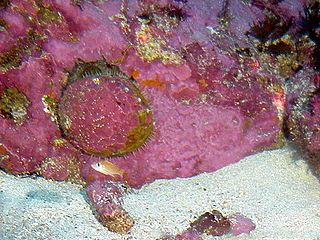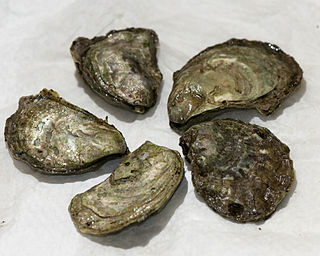
Oyster is the common name for a number of different families of salt-water bivalve molluscs that live in marine or brackish habitats. In some species, the valves are highly calcified, and many are somewhat irregular in shape. Many, but not all oysters are in the superfamily Ostreoidea.

The California two-spot octopus, often simply called a "bimac", is an octopus species native to many parts of the Pacific Ocean including the coast of California. One can identify the species by the circular blue eyespots on each side of its head. Bimacs usually live to be about two years old. They are closely related to Verrill's two-spot octopus. In 2015, the genome was sequenced.

San Quintín is a coastal town on the west coast of the Mexican state of Baja California, in the Municipality of San Quintin, some 190 km (118 mi.) south of the city of Ensenada on Mexican Federal Highway 1. The town is also in the middle of an important agricultural area, especially for growing strawberries and tomatoes. The largest nearby locality is Lázaro Cardenas, home to 16,294 people as of the 2010 census. The whole area houses roughly 25,000 people, up from 20,000 in 2000. This is the largest population cluster south of Ensenada within the state.

The Pacific oyster, Japanese oyster, or Miyagi oyster, is an oyster native to the Pacific coast of Asia. It has become an introduced species in North America, Australia, Europe, and New Zealand.

Oyster farming is an aquaculture practice in which oysters are bred and raised mainly for their pearls, shells and inner organ tissue, which is eaten. Oyster farming was practiced by the ancient Romans as early as the 1st century BC on the Italian peninsula and later in Britain for export to Rome. The French oyster industry has relied on aquacultured oysters since the late 18th century.

Ostrea is a genus of edible oysters, marine bivalve mollusks in the family Ostreidae, the oysters.

Yaquina Bay is a coastal estuarine community found in Newport, Oregon, United States. Yaquina Bay is a semi-enclosed body of water, approximately 8 km² (3.2 mi²) in area, with free connection to the Pacific Ocean, but also diluted with freshwater from the Yaquina River land drainage. The Bay is traversed by the Yaquina Bay Bridge. There are three small communities that border the Yaquina River and Bay; Newport, Toledo and Elk City. The Yaquina Bay in Newport is a popular tourist destination along the Pacific Coast Highway. It is also an important estuary for the ecology and economy of the area.

Ostrea edulis, commonly known as the European flat oyster, is a species of oyster native to Europe. In the British Isles, regional names include Colchester native oyster, mud oyster, or edible oyster. In France, Ostrea edulis are known as huîtres plates except for those that come from the Belon River estuary in Brittany, France, which are known as Belons.
The archaeological La Jolla Complex represents a prehistoric culture oriented toward coastal resources that prevailed during the middle Holocene period between c. 8000 BC and AD 500 in southwestern California and northwestern Baja California.

The white abalone, scientific name Haliotis sorenseni, is a species of large sea snail, a marine gastropod mollusk in the family Haliotidae, the abalones.

The common slipper shell,, has many other common names, including common Atlantic slippersnail, boat shell, quarterdeck shell, fornicating slipper snail, Atlantic slipper limpet and it is known|Britain]] as the "common slipper limpet". This is a species of medium-sized sea snail, a marine gastropod mollusc in the family Calyptraeidae, the slipper snails and cup and saucer snails.

Netarts Bay is an estuarine bay on the northern Oregon Coast of the U.S. state of Oregon, located about 5 miles (8.0 km) southwest of Tillamook. The unincorporated community of Netarts is located on the north end of the bay and Netarts Bay Shellfish Preserve, managed by Oregon Department of Fish and Wildlife, is located on the south side of the bay. The sand spit on the west side of Netarts bay is part of Cape Lookout State Park.

The striped shore crab, also known as the lined shore crab, is a small crab found on both rocky and hard-mud soft seashores of the northeastern and northwestern Pacific Ocean. In North America, this species occurs from central Oregon, south through California to near Ensenada, Baja California, Mexico. There is an isolated population with a wide range disjunction at Bamfield on Vancouver Island, Canada. The western Pacific population, including both Korea and Japan is isolated with a divergence time from the eastern Pacific population estimated between 0.8 and 1.2 Mya.

Ostrea lurida, common name the Olympia oyster, after Olympia, Washington in the Puget Sound area, is a species of edible oyster, a marine bivalve mollusk in the family Ostreidae. This species occurs on the northern Pacific coast of North America. Over the years the role of this edible species of oyster has been partly displaced by the cultivation of non-native edible oyster species.
Bonamia ostreae is a parasitic Rhizaria in the phylum Haplosporidia that can cause lethal infections in shellfish, particularly the European flat oyster, Ostrea edulis. Infection in oysters rarely results in clinical signs of disease and often the only indication of the infection is increased mortality. The Australian flat oyster, Ostrea angasi, has been infected with two similar Bonamia parasites, Bonamia exitiosa and B. roughleyi.
Cancer johngarthi is a species of crab that lives in the eastern Pacific Ocean from Mexico to Panama. It was separated from C. porteri in 1989, and is the subject of a small-scale fishery off Baja California.

Pteria sterna, commonly known as the rainbow-lipped pearl oyster or the Pacific wing-oyster, is a species of marine bivalve mollusk in the family Pteriidae, the pearl oysters. This oyster can be found in shallow water along the tropical and subtropical Pacific coast of America, its range including Baja California, Mexico and northern Peru.
Thousands of years prior to European settlement of the Pacific Northwest of the United States the native oyster species Ostrea lurida had been established as a valuable dietary resource for indigenous people living on the coastal waters. European settlers who began to colonize the Pacific Northwest developed an acquired taste for shellfish, especially oysters, a delicacy that were considered to be a symbol of wealth. In the early history of the Pacific Northwest, people satisfied their hunger for shellfish by harvesting naturally occurring oyster beds. It was initially believed that the populations of indigenous oysters were sufficient to supply both tribal and commercial harvest. A marketable industry was created on the export of oysters and soon exploitation of harvesting had depleted the natural oyster beds in California and Oregon. As a result Washington state became the main supplier to areas along the coast which had failed to establish any conservation practices. Noticing the economic value and decline of natural availability, farmers began efforts to cultivate oysters to try to satisfy demand. Over the years the oyster industry of the Pacific Northwest has gone from extremely lucrative to completely nonexistent, but still the industry has been able to adapt and survive.

Megapitaria squalida, the chocolate clam, is a species of bivalve mollusc in the family Veneridae. It was first described to science by George Brettingham Sowerby, a British conchologist, in 1835. The type specimen was collected by Hugh Cuming.
Saccostrea echinata, commonly known as the tropical black-lip rock oyster, blacklip rock oyster, blacklip oyster, and spiny rock oyster, is one of several tropical rock oyster species, occurring in tropical seas across the Indo-Pacific, including coastal waters across northern Australia to Noumea.















